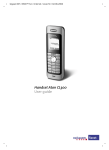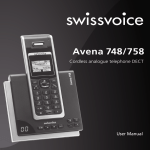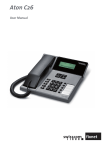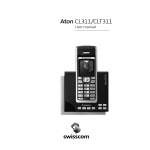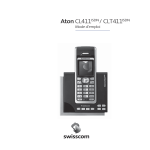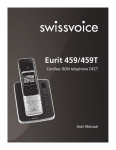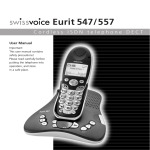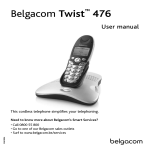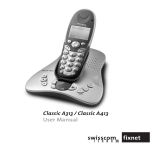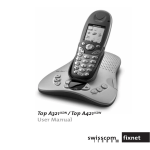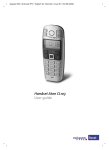Download AtonCL411ISDN
Transcript
Aton CL411ISDN User Guide Safety precautions This cordless DECT telephone is designed for connection to the Swiss public ISDN network. Any other use whatsoever is not permitted and is regarded as in violation of the provisions. The user manual with safety precautions is a part of the product package and must be passed on to the new owner on reselling. Caution: Warning/danger statement, follow safety precautions! ➭ Please note that the ringer for incoming calls as well as signal tones are emitted on the handset loudspeaker. Do not therefore hold the handset close to your ear while one of these functions is on, otherwise your hearing may be affected. ➭ Use only the supplied mains adapters 6V 600mA SSA-5W-05 EU 060060F for the base station! Rechargeable batteries Use only the supplied rechargeable batteries: NiMH AAA 800 mAh Model No. GP80AAAHC. Using other rechargeable batteries or non-rechargeable batteries/ primary cells can be dangerous and cause malfunctions in or damage to the telephone. Insert the batteries/type indication see chapter “Setting up the handsets”. Please note: ➭ Do not immerse batteries in water or throw in the fire. ➭ Rechargeable batteries can become warm while recharging. This is normal and not dangerous. ➭ Do not use any other type of charging unit since this may damage the batteries. ➭ Before using the telephone, wearers of hearing aids should note that radio signals can be picked up by the hearing aid and cause an unpleasant buzzing noise. ➭ Do not use your DECT cordless telephone in environments at risk from explosion (e.g. paintworks, petrol stations etc.) ➭ Do not position the base station in bathrooms or showers. ➭ The radio signals may influence the working of medical equipment. ➭ In the event of a power cut or if the batteries are discharged, your DECT cordless telephone will not function! ➭ The handset must not be charged up without batteries or the battery cover in place. ➭ Do not touch open contacts! Safety precautions Environmental impact 20405223en_ba_a0 At the end of its working life this device must not under any circumstances be disposed of as normal waste. It must be taken to a point of sale or central collection point for electronic and electrical devices in accordance with the Swiss Ordinance on the Return, Taking Back and Disposal of Electrical and Electronic Appliances (ORDEA). The individual materials are recyclable as indicated. By reutilizing, recycling or reusing them in any other form, you are making a major contribution towards environmental protection. 1 Contents Environmental benefits of the Aton CL411 ISDN The Aton CL411 ISDN has a low level of energy consumption and reduces radiation. Reduced power consumption Your telephone has a power-saving adapter plug and uses up to 60% less power than standard devices. Power consumption in standby mode is approx. 1.3 watt. Minimal radiation The Aton CL411ISDN with its preset Ecomode plus switches off all radiation when in idle status. During a call, the handset reduces the transmission power according to the distance from the base station. Detailed information on page 9 and 56. Safety precautions 20405223en_ba_a0 Introduction……………………………………………………………………………………9 Ecomode plus …………………………………………………………………………………9 Multi Handset Low Radiation Mode………………………………………………………9 Radiation reduction in communication …………………………………………………9 Electrical consumption reduction …………………………………………………………9 Setting up the telephone …………………………………………………………………10 Contents of the package ……………………………………………………………………10 Location ………………………………………………………………………………………10 Repeater ………………………………………………………………………………………11 Setting up the base station …………………………………………………………………11 Listening protection …………………………………………………………………………11 The stand ………………………………………………………………………………………12 Inserting the stand ………………………………………………………………………12 Removing the stand ………………………………………………………………………12 * Function dependent on network operator. Contact your network operator to find out whether this service is supported. 2 Contents Connecting the phone ………………………………………………………………………13 Setting up the handset ………………………………………………………………………14 Inserting the rechargeable batteries ……………………………………………………14 Charging the batteries……………………………………………………………………15 Language choice/Installation assistant ………………………………………………………16 Multiple Subscriber Numbers (MSN)…………………………………………………………17 Changing users……………………………………………………………………………17 20405223en_ba_a0 Getting to know your telephone ………………………………………………………18 Handset keys …………………………………………………………………………………18 Handset display symbols ……………………………………………………………………20 About the menus ……………………………………………………………………………21 Menu navigation …………………………………………………………………………21 Back to previous menu …………………………………………………………………21 End menu …………………………………………………………………………………21 Aton CL411ISDN base station …………………………………………………………………22 Telephoning …………………………………………………………………………………23 Making an external call ………………………………………………………………………23 Call preparation …………………………………………………………………………23 Ending a call ………………………………………………………………………………23 Accepting a call ………………………………………………………………………………23 Send DTMF/keypad information ……………………………………………………………23 Handsfree operation …………………………………………………………………………24 Handset/handsfree volume …………………………………………………………………24 Handset secrecy ………………………………………………………………………………24 Redial …………………………………………………………………………………………25 Redialling a number from the list ………………………………………………………25 Copying numbers from the redial list …………………………………………………25 * Function dependent on network operator. Contact your network operator to find out whether this service is supported. 3 Contents Deleting individual entries/entire redial list ……………………………………………25 Sending SMS messages from the redial list* …………………………………………26 Automatic redial ……………………………………………………………………………26 Group call (paging) ……………………………………………………………………………26 Keypad lock ……………………………………………………………………………………27 Internal calls……………………………………………………………………………………27 Enquiries ………………………………………………………………………………………28 Internal enquiry call ………………………………………………………………………28 External enquiry call………………………………………………………………………28 Brokering (switching between two calls) ……………………………………………………28 Call transfer to another handset ……………………………………………………………29 Internal call transfer ………………………………………………………………………29 External call transfer ……………………………………………………………………29 Three-way conference ………………………………………………………………………30 Conference assistant …………………………………………………………………………30 20405223en_ba_a0 Directory………………………………………………………………………………………31 Directory entries ………………………………………………………………………………31 Adding a new entry ………………………………………………………………………31 Tips for entering names/numbers ………………………………………………………31 Editing entries ……………………………………………………………………………32 Deleting directory entries/entire directory ………………………………………………32 Dialling numbers from the directory…………………………………………………………32 Sending SMS messages from the directory* ………………………………………………32 Copying directory entries ……………………………………………………………………33 Copying entries/entire directory to another handset …………………………………33 * Function dependent on network operator. Contact your network operator to find out whether this service is supported. 4 Contents ETV® Online …………………………………………………………………………………34 ETV® Online query ……………………………………………………………………………34 ETV® queries ……………………………………………………………………………34 Saving ETV® information in your directory ……………………………………………34 Calls list* ……………………………………………………………………………………35 Viewing/dialling a number from the calls list ………………………………………………35 Sending SMS messages from the calls list* …………………………………………………35 Saving numbers from the calls list to the directory…………………………………………36 Deleting individual entries ……………………………………………………………………36 Deleting the entire calls list …………………………………………………………………36 Audio …………………………………………………………………………………………37 Handset/base station ringer …………………………………………………………………37 Ringer melodies ………………………………………………………………………………37 Personal ringer melodies …………………………………………………………………37 Recording ringer melodies ………………………………………………………………37 Beeps …………………………………………………………………………………………38 Key beep …………………………………………………………………………………38 Range beep ………………………………………………………………………………38 Charging beep ……………………………………………………………………………38 Accu beep …………………………………………………………………………………38 Confirmation beep ………………………………………………………………………38 20405223en_ba_a0 Family …………………………………………………………………………………………39 Direct call (baby call) …………………………………………………………………………39 Room monitoring (baby surveillance) ………………………………………………………40 Games …………………………………………………………………………………………40 5 Contents Charges ………………………………………………………………………………………41 Cost of last call ………………………………………………………………………………41 Summary ………………………………………………………………………………………41 Settings ………………………………………………………………………………………41 Type of Display ……………………………………………………………………………41 Charge factor ……………………………………………………………………………41 Currency …………………………………………………………………………………41 20405223en_ba_a0 Calendar/clock ………………………………………………………………………………42 Alarm …………………………………………………………………………………………42 Appointments …………………………………………………………………………………42 Adjust time/date ………………………………………………………………………………42 Network functions (supplementary services) …………………………………………43 Call forwarding ………………………………………………………………………………43 Unconditional ……………………………………………………………………………43 No reply ……………………………………………………………………………………43 Busy ……………………………………………………………………………………… 43 Call waiting ……………………………………………………………………………………44 Activating/deactivating call waiting ……………………………………………………44 Accepting a waiting call …………………………………………………………………44 Anonymous call (Identification restriction) …………………………………………………45 Parking …………………………………………………………………………………………45 Park/unpark ………………………………………………………………………………45 Park code …………………………………………………………………………………45 Callback ………………………………………………………………………………………46 Call back on busy (Completion of Calls to Busy Subscriber/CCBS) …………………46 Malicious Call Identification (MCID) …………………………………………………………46 Combox (Network answer machine) ………………………………………………………47 Provider ………………………………………………………………………………………47 6 Contents Access to the Swisscom Contact Center ………………………………………………48 20405223en_ba_a0 SMS ……………………………………………………………………………………………49 SMS – Short Messaging Service ……………………………………………………………49 Writing SMS messages ………………………………………………………………………49 Inbox……………………………………………………………………………………………50 Drafts …………………………………………………………………………………………50 Outbox …………………………………………………………………………………………50 Templates ………………………………………………………………………………………51 Settings ………………………………………………………………………………………51 Service centres ……………………………………………………………………………51 Send service ………………………………………………………………………………51 New SMS alert ……………………………………………………………………………51 Settings ………………………………………………………………………………………52 Language ………………………………………………………………………………………52 Presentation……………………………………………………………………………………52 Display ……………………………………………………………………………………52 • Wallpaper ………………………………………………………………………………52 • Menu color ……………………………………………………………………………52 • Font ……………………………………………………………………………………52 • Contrast …………………………………………………………………………………53 • Backlight ………………………………………………………………………………53 • Screen Saver ……………………………………………………………………………53 Keypad backlight …………………………………………………………………………53 Telephony………………………………………………………………………………………54 Automatic DTMF …………………………………………………………………………54 Auto Talk …………………………………………………………………………………54 System PIN ……………………………………………………………………………………54 PBX ……………………………………………………………………………………………55 Repeater ………………………………………………………………………………………55 7 Contents Ecomode plus …………………………………………………………………………………56 Multi Handset Low Radiation Mode ……………………………………………………56 Radiation reduction in communication …………………………………………………56 MSN settings …………………………………………………………………………………57 Assigning an MSN ………………………………………………………………………57 Allocating an MSN ………………………………………………………………………57 Additional handsets/base stations ………………………………………………………58 Registering additional handsets………………………………………………………………58 Deregistering a handset ………………………………………………………………………58 Selecting the base station ……………………………………………………………………58 PBX access ……………………………………………………………………………………59 Compatibility …………………………………………………………………………………59 Access Code …………………………………………………………………………………59 Entering the Access Code ………………………………………………………………59 Incoming Code on/off ……………………………………………………………………59 20405223en_ba_a0 Maintenance …………………………………………………………………………………60 Reset……………………………………………………………………………………………60 Software version ………………………………………………………………………………60 Installation assistant …………………………………………………………………………60 Faults and trouble-shooting …………………………………………………………………60 Important information ……………………………………………………………………61 Approval and conformity ……………………………………………………………………61 CE symbol ……………………………………………………………………………………61 Warranty and support ………………………………………………………………………62 Support ……………………………………………………………………………………62 Warranty …………………………………………………………………………………62 Restrictions ………………………………………………………………………………62 Help ……………………………………………………………………………………………62 Cleaning – when necessary …………………………………………………………………62 8 Introduction Ecomode plus Your Aton CL411 ISDN is fitted with the latest innovations in terms of reduction of electromagnetic radiation (so called “electro-smog”) as well as electrical power consumption reduction. The Ecomode plus includes three main features: Multi Handset Low Radiation Mode When in standby, the electromagnetic radiation is automatically shut down between the base station and the handset(s). This works with one ore more handsets declared to the base station. The handset(s) and the base station are waiting for a wake-up signal should a call come in, when you activate one handset or when the system synchronises some data. In other terms, electromagnetic radiation is generated only when the system is in use! (refer to chapter Settings/Ecomode plus for settings). Radiation reduction in communication Up to 70% radiation reduction of the handset is achieved when it is near the base station. The handset’s power transmission are regulated; the power transmitted from the handset is automatically reduced to the lower level, depending on the distance to the base station (refer to chapter Settings/Ecomode plus for settings). Electrical consumption reduction 20405223en_ba_a0 The efficiency of the switching power supply reduces the electrical consumption of the telephone up to 60%. Combined with the Radiation Reduction and Multi Handset Low Radiation Mode it contributes to save energy and costs. 9 Setting up the telephone Contents of the package ➭ ➭ ➭ ➭ ➭ ➭ ➭ ➭ 1 1 1 1 2 1 1 1 base station connector cable (ISDN) mains unit 6 V 600 mA SSA-5W-05 EU 060060F handset rechargeable batteries NiMH AAA 800 mAh Model No. GP80AAAHC user manual (3 languages ger/fr/it) belt clip (mounted) environmental card (Swisscom) Location To obtain the best possible range, we recommend positioning the telephone in a location central to your sphere of activity. Avoid positioning the telephone in niches, recesses and behind steel doors. The maximum range between the base station and handset is approximately 40 meters indoors and 250 meters outdoors. Depending on the surrounding conditions as well as spatial and structural factors, the range may be smaller. Silent zones can occur due to the digital transmission in the frequency range used – even within the range, depending on the structural environment. In this case the transmission quality may be reduced through the increased incidence of short breaks in transmission. Normal call quality can be restored if you move slightly out of the silent zone. If the range is exceeded, the call will be disconnected unless you move back into range within five seconds. 20405223en_ba_a0 To avoid radio signal interference from other electronic equipment, we recommend that the base station and handset are situated at the greatest possible distance (min. 1 meter) from other equipment. 10 Setting up the telephone Repeater You can use a repeater to extend the range and receiving power of your base station. The repeater must first be registered and activated on the base station. (Your telephone is delivered with the default setting “off”). Note - For settings refer to chapter “Settings, Repeater”. - Repeater and Ecomode plus mode are mutually exclusive. Setting up the base station ➭ Do not expose the base station to direct sunlight. ➭ Protect the base station against moisture. Do not position the base station in rooms exposed to condensation, corrosive steam or excessive dust. Condensation can be present in basements, garages, conservatories or sheds. ➭ The ambient temperature must be between 5 °C and 40 °C. Position the base station in a clean, dry and well-aired location. Choose a place which is stable, level, and not subject to vibrations. To avoid mutual interference, do not position the base station in the immediate vicinity of electronic equipment such as hi-fi systems, office equipment or microwave ovens. Avoid positioning the telephone near heat sources such as heating elements or near obstacles such as metal doors, thick walls, niches and cupboards. There is no mains switch on the base station. For this reason the socket to which it is connected must be easy to access. 20405223en_ba_a0 Listening protection When you are on the telephone, the base station and handset are connected to each other over a radio link. The base station handles switching between the telephone network and the handset. To ensure that no-one can eavesdrop or telephone at your cost, the base station and handset exchange codes. If the codes do not match, the connection with third-party handsets cannot be set up. 11 Setting up the telephone The stand Inserting the stand 1. Lay the base station down on the table (front side down). 2. Insert the stand in the grooves ➀ of the base station and press it on lightly. 3. Make sure that the lower support tabs ➁ click into the slots provided. There is a definite click when the stand is properly seated. 1 2 1 1 2 2 1 2 Removing the stand 20405223en_ba_a0 1. Lay the base station down on the table (front side down). 2. Fix the base station with one hand. 3. With the other hand press the two tabs ➀ right and left simultaneously and pull the stand out. 12 Setting up the telephone Connecting the phone Before you can start using your telephone you must plug in the telephone connector cable and the mains cable. Note The cables must pass above the stand to assure the proper standing of the base station. ➁ Socket for mains cable ➀ Socket for telephone connector cable Safety note Use only the supplied mains adapter 6 V for the base station! 600 mA SSA-5W-05 EU 060060F ➀ Telephone connector cable Insert the the ISDN telephone connector cable in the socket marked with the telephone symbol on the base station. Insert the other plug in your telephone connection socket. ➁ Mains cable 20405223en_ba_a0 First, insert the mains cable in the socket marked with the mains connector symbol on the base station. Then insert the mains plug in the 230 V socket. Note Your telephone will not function if the mains connector is not plugged in or during a power failure (no emergency mode). 13 Setting up the telephone Setting up the handset Your handset will be ready for operation (for making or accepting calls) only once the batteries have been fully charged for the first time. Inserting the rechargeable batteries The bottom part of the handset contains a battery compartment for housing two type AAA batteries (microcells). Removing the belt clip: Press on the top of the clip and shift it upwards to remove it. Removing the battery compartment cover: 20405223en_ba_a0 Slide the battery compartment cover downwards (approx.3 mm) and lift. Inserting the two rechargeable batteries (note the polarity!): Insert the batteries in the battery compartment. Make sure the polarity is correct. Insert the batteries so that the flat end (negative polarity) of the battery is pressing against the spring. The handset will not function if the batteries are incorrectly inserted. This may result in damage. Replace the compartment cover by placing it approximately 3 mm offset and slide it upwards until it clicks into place. 14 Setting up the telephone Charging the batteries The batteries are not yet charged when you first unpack the telephone. Insert the handset in the base station for charging. The flashing battery symbol on the handset shows the charging status. The batteries will take around 14 hours to fully charge. Note • Do not insert the handset in the base station without batteries. • Do not use any other type of charging unit since this may damage the batteries. The following symbols indicate the charging status on the handset display: Charging status “full” Charging status “1/2” Charging status “empty” Once the new batteries have been inserted, the display on the handset indicates the actual charging status only after a complete charging cycle. Your telephone is now ready to use. Important! Please note: after you have inserted the batteries for the first time, the battery display will indicate the correct information on the charging status only after a complete charging cycle. 20405223en_ba_a0 Use only the supplied rechargeable batteries NiMH AAA 800 mAh Model No. GP80AAAHC. Never use disposable batteries/primary cells. 15 Setting up the telephone Note You can replace the handset in the base station after every call. Charging is electronically controlled to ensure optimal charging of batteries in different charge states. Avoid removing the batteries from the handset for no good reason, since this affects the optimum charging cycle. Because your telephone is fitted with a low-radiation mechanism, the antenna automatically switches off in standby mode and cannot therefore emit any radiation. Your telephone is delivered with this function switched on. You can telephone for up to 12 hours with fully charged batteries. The handset has a standby time of up to 120 hours. If the battery charge status has reached its lower limit, the battery symbol ( ) flashes in the display and a warning signal is heard. You have 10 minutes of talk time left. Language choice/Installation assistant The language choice appears. Press to confirm. to scroll to the desired language and press OK An installation assistant guides you then step by step through the setup procedure for your telephone. Enter time and date according to the displayed instructions. The installation assistant will re-appear following a reset of the telephone (reset to default settings). 20405223en_ba_a0 Note 16 Setting up the telephone Multiple Subscriber Numbers (MSN) When you ordered your ISDN connection, your network operator will have assigned you several Multiple Subscriber Numbers (MSN). You can assign these numbers to different devices or assign individual numbers to different users. Every MSN (user) can then define individual settings for the number assigned to him or her. Your telephone can manage up to 5 MSNs. To use all the functions, you must set up at least one MSN with user name (see section on “Assigning an MSN”). Changing users To change users, press the softkey under MENU. Use to scroll to CHANGE USER and select the relevant user. The current user is displayed. You can now access the activated user’s call lists, charge displays and individual settings. To find out how to set preferences for individual MSNs, refer to the section on “MSN settings”. The CHANGE USER menu can only be accessed if more than one MSN has been programmed. 20405223en_ba_a0 Note 17 Getting to know your telephone Handset keys Earpiece Backlit display Navigation key Redial Internal call key Softkey (multifunctional key) Softkey (multifunctional key) Int Directory Talk key 1 Alphanumerical keypad 4 GHI 7 PQRS 20405223en_ba_a0 Asterisk key Enquiry key with flash function Message key/Calls list “End call” key 2 ABC 5 JKL 8 TUV 0 3 DEF 6 MNO 9 WXYZ Activating the key lock Key “ETV® Online” R Microphone 18 Getting to know your telephone Softkeys (multifunctional keys) Right softkey: Choose menu options, confirms entries/settings. Left softkey: returns to previous menu step. In idle mode: Call Swisscom Hotline. Navigation key For scrolling up/down or right/left. Redial Open redial list. Message key Access to the calls list (answered/missed calls), SMS*. Opens the Directory. Int Internal call key For conducting handset-to-handset calls. Call key For conducting and accepting calls and switching to handsfree. “End call” key Press briefly to end a call or return to standby mode. Press and hold down to switch the handset on/off. 0 … 9 WXYZ Alphanumerical keypad For dialling telephone numbers. Letters printed on housing. Press and hold down “0” when entering a telephone number to insert a dialling pause between two digits. 1 Combox Press and hold down for direct access to network answer machine messages. 3 Call anonymously Press and hold down to suppress caller ID for next call. DEF Asterisk key For entering asterisks. Press and hold down to switch handset ringer on/off. Hash key For entering the hash symbol. Press and hold down to switch keylock on. Keypad locked A locked keypad prevents numbers being dialled inadvertently. 20405223en_ba_a0 R Enquiry key Press key R to activate some network functions. Key “ETV® Online”*. * Function dependent on network operator. Contact your network operator to find out whether this service is supported. 19 Getting to know your telephone Handset display symbols The following symbols are displayed on your handset. Coverage symbol Reception displayed when the handset is within range of the base station. Flashes when out of range of the base station or not registered with the base station. Alarm set Indicates that the alarm is set. Handsfree on Indicates that handsfree speaking is activated. Battery full Indicates that the batteries are fully charged. Battery empty Indicates that the batteries are almost discharged. Unanswered calls* Displayed if you have unanswered calls in the calls list. You have new SMS messages* Indicates that you have new SMS messages. Active call Indicates that a call is in progress. You have messages on your Combox* Displayed if you have new messages on your network answer machine. Ringer off Indicates that the ringer is switched off. Keypad lock Indicates that the keypad is locked. Internal call Indicates a handset-to-handset call. ) Auto Redial 20405223en_ba_a0 Indicates that Auto Redial is activated. * Function dependent on network operator. Contact your network operator to find out whether this service is supported. 20 Getting to know your telephone About the menus Menu navigation In standby when pressing the softkey under MENU the display shows the menu “Directory” together with the corresponding symbol. Pressing the navigation key (up /down) will lead to the further available menus. The title of the selected menu appears together with the corresponding symbol. Your handset provides you with an easy-to-follow menu. As a rule, every menu offers a list of options. To select main menu, sub-menu and options, press the softkey below the corresponding display text. With the handset switched on and ready for use, press the softkey under MENU to open the menu selection and use the navigation key to scroll to the menu or option you are seeking. Press OK to open the options list, use the navigation key to scroll down the list to the preferred option, and confirm the option by pressing OK. Back to previous menu Press BACK to return to the previous menu. End menu 20405223en_ba_a0 To exit a menu, press the softkey under BACK. If you want to return to standby mode, confirm by pressing . 21 Getting to know your telephone Aton CL411ISDN Aton CL411 ISDN base station 20405223en_ba_a0 “In operation” LED Group call on handsets (paging) 22 Telephoning Making an external call Press , wait for the dialling tone and dial the number. Call preparation First, enter the number. Press to dial the number. If you enter an incorrect number, you can: • delete it by pressing repeatedly the foxkey under . • move the cursor to the desired character by pressing the navigation key (left/right). Ending a call Press or replace the handset in the base station. Accepting a call The caller’s number or name (if already saved in the directory) is displayed only if your network operator supports the Caller Identification Presentation* (CLIP) function. Press to accept the call. Send DTMF/keypad information By switching to temporary DTMF you can press the softkey under OPTIONS, DTMF to send control signals, e. g. for the network answer machine, during a call. 20405223en_ba_a0 Note If you have activated “Automatic DTMF” in the SETTINGS, TELEPHONY menu, there is no need to switch to temporary DTMF. Temporary DTMF is automatically deactivated when you end the call. * Function dependent on network operator. Contact your network operator to find out whether this service is supported. 23 Telephoning Handsfree operation You can use the handsfree function to conduct calls without holding the handset in your hand and allow others present in the room to take part in the call. Activating handsfree before a call: 1. Press . The display shows . Press again. The display shows hear the ringing signal over the handset loudspeaker. 2. Press and you can to deactivate handsfree speaking. Switching to handsfree speaking during a call: Press . To deactivate handsfree speaking, press again. Handset/handsfree volume You can adjust the handset and handsfree loudspeaker volume in 5 steps. Press during a call to adjust the volume. The selected setting is saved after the end of the call. Note The handset and handsfree loudspeaker volumes are independent but the setting procedure is identical. Handset secrecy During a call you can talk to someone else in the room without the caller hearing. 20405223en_ba_a0 1. Press the softkey under MIC ON/MIC OFF during a call. This switches handset secrecy on and your caller cannot hear you. 2. Press the softkey under OFF to return to the call. 24 Telephoning Redial The 20 last-dialled numbers are saved in a redial list. If a name and number are already stored in the directory, the name is shown instead of the number. Redialling a number from the list If the telephone is in standby mode: Press to open the redial list and press to scroll through the list. Press as you have reached the number you are seeking. Note as soon • To open the redial list the telephone must be in standby mode. After having pressed the talk key the redial list cannot be opened with the -key. • If the redial list is empty, a message to this effect appears. Copying numbers from the redial list You can copy a number from the redial list to the directory. Press to open the redial list. Use to scroll through the list to find the number you are seeking, and press the softkey under OPTIONS, SAVE NUMBER. Enter the name and associated number and save the entry. Note If the number is already in the directory, the Save function is not displayed. 20405223en_ba_a0 Deleting individual entries/entire redial list Press to open the redial list. Scroll through until you reach the entry you are seeking. Press the softkey under OPTIONS and delete the entry or the entire list. 25 Telephoning Sending SMS messages from the redial list* 1. Press the softkey under . Use to scroll through the list to find the entry you are seeking, and press the softkey under OPTIONS, WRITE MESSAGE. 2. Write and send your SMS message. Automatic redial When the called number is busy, the automatic redial function can be activated from the “Options” menu. The interval as well as the number of redials can be set in the “Options” menu. Once automatic redial is activated, the phone emits an alert (for approx. 30 seconds) after a set interval. The user then has three options: – Automatic redial can be deactivated using the left softkey (OFF). This cancels dialling and deactivates the ringtone. – If the right softkey (YES) or the talk key is pressed, the set number is automatically dialled and at the same time automatic redial is deactivated. If the called number is still busy, automatic redial must be re-activated via the “Options” menu. – If, while the alert is emitted, no key is pressed or the “End call” key is pressed, redial remains activated and the next reminder signal is emitted after the set interval. This is repeated for as many times as redials are programmed. Note The interval therefore applies only to option 3. Group call (paging) You can activate a group call to locate a mislaid handset. 20405223en_ba_a0 1. Press on the base station. The mislaid handset rings. 2. Press again to end the ringing signal or press softkey under “Reject”. on the handset or the * Function dependent on network operator. Contact your network operator to find out whether this service is supported. 26 Telephoning Keypad lock If you want to carry the handset around in your pocket, you can activate the key lock. This prevents you inadvertently dialling a number. 1. Press and hold down . The display shows KEYPAD LOCKED. 2. To unlock the keypad, press the softkey under UNLOCK, then press Note . If the keypad is locked, • you can dial emergency numbers (in call preparation only) and incoming calls can still be accepted. • you cannot dial a number or access menus. Internal calls You can call other handsets which are registered with your base station. This allows you to make internal calls free of charge. 1. Press Int, dial the relevant handset number and press OK to confirm. Pressing Int automatically dials the second handset if only two handsets are registered with the base station. 2. Press 20405223en_ba_a0 Note to end the call. • If you receive an external call while conducting an internal call, the base station and every handset which is not in use will ring. • If a handset is in use, you will hear a signal alerting you to the incoming external call. Press the softkey under OPTIONS, ACCEPT/END to end the internal call and accept the external call. Or press the softkey under OPTIONS, ACCEPT/HOLD to put the internal call on hold or under OPTIONS, REJECT to reject the external call on this handset. 27 Telephoning Enquiries Internal enquiry call You are conducting a call and want to call an internal party without ending the external call. Internal enquiries are managed by the base station and are not dependent on your network operator's available services. External enquiry call Procedure: 1. You are conducting a call and want to call another external party without ending the active external call. 2. Press the enquiry key R to start the external enquiry. Brokering (switching between two calls) You have two active calls (1 internal and 1 external), one of which is on hold. 1. Press the key Int or the softkey under OPTIONS, BROKERING to switch between the call partners. Press the softkey under OPTIONS, CONFERENCE to connect all three call partners with each other. 2. Press to end one of the calls. The remaining call partners are automatically connected with each other. 20405223en_ba_a0 Note Brokering between two external call partners is managed by the public telephone network and is therefore dependent on your network operator’s available services (network functions). Find out whether these network functions are supported. 28 Telephoning Call transfer to another handset Internal call transfer You can transfer the call you are conducting to another handset (= switching). 1. Press Int and dial the handset to which you wish to transfer the call. The external caller is put on hold. 2. If the second handset answers, you can talk to the internal call partner without the external caller hearing you. Press to transfer the call. Note • You cannot use the Int key if the call duration is not displayed. • If the second handset does not answer, you can end the ringing signal and return to the original call by pressing the softkey under END. External call transfer 20405223en_ba_a0 You can transfer an incoming call to another telephone directly by pressing the softkey under OPTION, CD. 29 Telephoning Three-way conference You can set up a three-way conference with 2 external call parties. 1. Press the softkey under OPTIONS, CONFERENCE to connect all three call partners with each other. Each call partner can leave the conference call by pressing . 2. Press the softkey under OPTIONS, END CONFERENCE to end the conference and return to brokering. 3. Press then the softkey under OPTIONS, BROKERING to talk to each call partner individually. Conference assistant You can use the conference assistant to set up a three-way conference with 2 external call parties. 1. Scroll to NET FUNCTIONS, CONF. ASSIST. and press OK to confirm. 2. Dial the number of the call partner or search for it in the directory. Once the connection is set up, tell the call partner that you are setting up a three-way conference call. The call partner is put on hold. 3. Press the softkey under GO ON. 4. Dial the number of the second call partner or search for it in the directory. Press the softkey under GO ON as soon as the second call partner responds. The three-way conference call is now automatically activated. 20405223en_ba_a0 Note If the second call partner does not answer, you can return to the first call partner by pressing the softkey under END. 30 Directory You can store up to 250 names and numbers in the directory on each handset. Every entry contains a name and telephone number. Names can be up to 24 letters long and numbers up to 24 digits long. Directory entries Adding a new entry If the telephone is in standby mode: 1. Press . All entries are displayed in alphabetical order. 2. Press the softkey under OPTIONS. Select NEW ENTRY and enter the new name, number, status (PBX/external) and preferred provider. You can also set “Call anonymously” to “on” if you wish to withhold your number when calling. Save the entry. Note If the directory is empty, a message to this effect is displayed. Tips for entering names/numbers • Press 0 to insert a space, 0 or 1 to enter a symbol. • The available special characters appear in the lower display line. Press the relevant key repeatedly to scroll through the characters. to switch between upper and lower case 20405223en_ba_a0 • When entering names, you can press lettering. 31 Directory Editing entries 1. Press . Use to scroll through the list to find the entry you are seeking, and press the softkey under OPTIONS. 2. Select EDIT ENTRY, modify the name and/or number and save the entry. Deleting directory entries/entire directory You can delete individual entries or the entire directory. 1. Press . Use to scroll through the list to find the entry you are seeking, and press the softkey under OPTIONS. 2. Delete the entry or the entire list. Dialling numbers from the directory 1. Press . All entries are displayed in alphabetical order. 2. Use to scroll through the directory, select the entry you are seeking and press The number is displayed and dialled. You can also search by name: press the first letters of the name and press . to confirm. Sending SMS messages from the directory* 1. Press . Use to scroll through the list to find the entry you are seeking, and press the softkey under OPTIONS. 20405223en_ba_a0 2. Select “Write message”, confirm with OK. 3. Write and send your SMS message. * Function dependent on network operator. Contact your network operator to find out whether this service is supported. 32 Directory Copying directory entries If you operate several handsets, you can copy entries from one handset to another. This way, you only have to enter names and numbers once. While you are copying entries from one handset to another, you can make external calls on another handset registered with the base station. If the entire directory is copied, it overwrites all entries on the other handset. If the directory on the handset to which you are copying is full, a message to this effect is displayed. Copying entries/entire directory to another handset You can copy individual entries or the entire directory from one handset to another provided both handsets are registered with the base station. 1. Press and to select the entry you wish to copy. Press the softkey under OPTIONS. Select the submenu you are seeking and press OK to confirm. 2. Select the number of the destination handset and press OK to confirm. 3. Confirm the option with YES on the relevant handset. Note • The copy procedure is aborted if an incoming call is received. • If you are copying an entire directory, all entries transferred before the call are saved. 20405223en_ba_a0 • You cannot perform the copy procedure if the handset to which you wish to copy is conducting a call. 33 ETV ® Online ETV ® Online query ETV ® Online is a service which gives you direct access to the Swisscom electronic directory (ETV ® = Elektronisches Teilnehmer-Verzeichnis, Swisscom Directories AG). As soon as an unknown number appears on your display, you can press to access the ETV ® and within a few seconds obtain the caller’s name and address. ETV® queries You can call up the ETV ® directly: – while the phone is ringing (incoming call) – during a call – when entering a number in dialling preparation You can also consult the ETV® while in the following lists: – Caller lists (answered/unanswered) – Redial list Note • ETV ® queries are subject to a charge. • The ETV ® Online access number is pre-installed. If you need to change the access number*, you can reprogram it in the NET FUNCTIONS, ETV®-Online menu. Saving ETV ® information in your directory 20405223en_ba_a0 Once you have obtained the information from the ETV ®, you have the option of directly saving the number and name to your directory (press the softkey under SAVE). * Your telephone is delivered with the Swisscom access number, 081 286 61 30, preprogrammed. 34 Calls list* If your network operator supports caller ID presentation* (CLIP), the caller’s number (if he did not not withheld his own number) is displayed before you accept the call. If you have received new calls, a message to this effect appears in the display. A list is kept of answered and unanswered calls. The calls list can hold up to 30 entries. If the list is full, the oldest entry is overwritten by the most recent entry. Note If the calls list is empty, a message to this effect is displayed. Viewing/dialling a number from the calls list Press . Select CALLS LIST to open the calls list, press OK to confirm. Select ANSWERED CALLS or MISSED CALLS, press OK to confirm. Press through the list. Press to dial the number. to scroll Sending SMS messages from the calls list* 1. Press . Select CALLS LIST to open the calls list, press OK to confirm. to scroll Select ANSWERED CALLS or MISSED CALLS, press OK to confirm. Use through the list to find the entry you are seeking, and press the softkey under OPTIONS, WRITE MESSAGE. 20405223en_ba_a0 2. Write and send your SMS message. * Function dependent on network operator. Contact your network operator to find out whether this service is supported. 35 Calls list* Saving numbers from the calls list to the directory 1. Press . Select CALLS LIST to open the calls list, press OK to confirm. Select ANSWERED CALLS or MISSED CALLS, press OK to confirm. Scroll through until you reach the entry you are seeking. 2. Press the softkey under OPTIONS, SAVE NUMBER. Enter the associated name and save the entry. Deleting individual entries 1. Press . Select CALLS LIST to open the calls list, press OK to confirm. Select ANSWERED CALLS or MISSED CALLS, press OK to confirm. Scroll through the relevant calls list until you reach the entry you are seeking. 2. Press the softkey under OPTIONS, DELETE CALL and delete the entry. Deleting the entire calls list 20405223en_ba_a0 Press . Select DELETE ALL CALLS to delete the entire list. * Function dependent on network operator. Contact your network operator to find out whether this service is supported. 36 Audio Procedure: 1. Press the softkey under MENU. Press to scroll to AUDIO ad press OK to confirm. 2. Scroll to the relevant submenu and make the relevant settings: Handset/base station ringer You can programme different ringer melodies on the handset and base station to signal external and internal calls. Choose from the 5 standard ringer melodies and 10 polyphonic ringer melodies (handset only). Set the preferred ringer melodies and associated volume for external/internal calls. You can also set an ascending volume. Use the possibility to assign the melody/picture you want to an entry in the directory. When you get a call from this participant, you hear the personalised melody and see the defined picture in the display. Ringer melodies Personal ringer melodies You can manage up to 10 personal ringer melodies. Recording ringer melodies 20405223en_ba_a0 You can record personal melodies or noises on your telephone. 37 Audio Beeps Your telephone supports various tones which you can activate or deactivate: Key beep Every time a key is pressed, a brief beep is heard. Range beep A warning beep is sounded if you exceed the maximum range. Move closer to the base station. Charging beep When you insert your handset in the base station, the batteries are automatically charged up. A short beep is heard. Accu beep Sounds when the batteries are running low. Confirmation beep 20405223en_ba_a0 Settings and entries are confirmed by a short beep. 38 Family Procedure: 1. Press the softkey under MENU. Press to scroll to FAMILY and press OK to confirm. 2. Scroll to the relevant submenu and make the relevant settings: Direct call (baby call) If you activate direct call on your telephone, the handset dials a preprogrammed number when any handset key is pressed. “Direct call” can be very useful, especially for parents: If the parents are not at home, the children can reach a predefined number simply by pressing any key on the handset. The direct call number must be preprogrammed by the parents beforehand. • You must deactivate the direct call function to restore your telephone’s normal functions. Note • Please note that direct call may not function in exceptional cases, e.g. if the preprogrammed number is busy, if the preprogrammed mobile phone number has no reception, in case of a power outage or when the recheargable batteries are empty. 20405223en_ba_a0 Note 39 Family Room monitoring (baby surveillance) You can set a baby call/noise alarm. Once this function is set, your phone monitors noises in its immediate vicinity and triggers a call to the programmed number if the noise exceeds a set level (defined by the user). The person called hears the noises and is alerted to the fact that, for instance, a child is crying in the room. Note • If room monitoring is active, incoming calls are not signalled on the handset you have activated room monitoring. • You must deactivate the room monitoring function to restore your telephone’s normal functions. • Please note that room monitoring may not function in exceptional cases, e.g. if the preprogrammed number is busy, if the preprogrammed mobile phone number has no reception, in case of a power outage or when the recheargable batteries are empty. Games Your telephone offers a choice of two games. Press the softkey under MENU, use to scroll to FAMILY, GAMES and press OK to confirm. Select the game you wish to play. Please note the rules of the game and follow the operating instructions on your telephone. You can still be reached while playing a game. 20405223en_ba_a0 Note 40 Charges Procedure: 1. Press the softkey under MENU. Press to scroll to CHARGES and press OK to confirm. 2. Scroll to the relevant submenu and make the relevant settings: Cost of last call You can display the cost of the last call. Summary You can display the total per handset and the total for all calls. Settings Type of Display You can display the cost or duration of a call. The following settings must be made before you can display costs: Charge factor To display costs accurately, you must set the charge per unit (factor). The factor for the Swisscom ISDN network is FR. 0.10. Currency In the Swisscom ISDN network the currency is transmitted and displayed in FR. 20405223en_ba_a0 Note • On delivery the charge factor and currency are preprogrammed. • Note that for technical reasons the displayed charges may differ from the amount billed. The amount indicated on your phone bill is binding. • If you are using a provider, charge information may not be available. 41 Calendar/clock Procedure: 1. Press the softkey under MENU. Press to confirm. to scroll to CALENDAR/CLOCK and press OK 2. Scroll to the relevant submenu and make the relevant settings: Alarm To set the alarm, you need to activate the alarm function and enter the time and preferred alarm melody. You can choose from 5 standard and 10 polyphonic alarm melodies. Note The alarm only sounds on the handset on which it has been set. Appointments Your telephone also acts as an appointments reminder: You can set 5 different appointment reminders. A signal is heard on the handset at the defined time. Note As soon as the time of the appointment arrives, it is displayed and the phone rings during a certain time. By pressing the softkey under SILENCE (or after the ringing), the appointment will further be displayed. If you do not need the reminder in the display any longer, press CLEAR. Adjust time/date 20405223en_ba_a0 You must set the time, date and day. Note • If the power supply is cut, the settings are lost and must be reprogrammed. • You can also set the time format (12/24 hours). 42 Network functions (supplementary services) To activate certain network functions, you have to send special codes to the network. Often these codes contain special characters such as or . In some cases, the so-called flash signal is required. You can enter this by pressing key R . Contact your network operator for details and the appropriate codes to activate these services. Procedure: 1. Press the softkey under MENU. Press to confirm. to scroll to NET FUNCTIONS and press OK 2. Scroll to the relevant submenu and make the relevant settings: Call forwarding Call forwarding allows callers to reach you even if you are not near your own telephone. Choose the relevant type of call forwarding (unconditional, no reply, busy) in the submenu SWITCH ON or SWITCH OFF and enter the forwarding number (i.e. the number to which calls are to be forwarded). Unconditional Incoming calls are forwarded immediately. No reply Incoming calls are forwarded after a delay (fixed time or number of rings). Busy Calls are forwarded if the line is busy. Once you have defined the call forwarding option, enter the forwarding number (i.e. the number to which calls are to be forwarded). 20405223en_ba_a0 You can: • check the call forwarding status • edit or delete the forwarding number (forwarding numbers are not saved in the telephone) • deactivate call forwarding. 43 Network functions (supplementary services) Call waiting With this service you can have a telephone conversation and still be informed that someone else is calling you. In this case you will hear the “Call waiting” tone and you can answer this call. Activating/deactivating call waiting 1. Press the softkey under MENU. Press to scroll to SETTINGS, MSN SETTINGS, CALL WAITING and press OK to confirm. 2. You can then activate or deactivate the function Call waiting. Accepting a waiting call Press the softkey under OPTIONS. You can then press – Reject 2nd call: Reject the waiting call, continue the active call. – Accept/End: Accept the waiting call, end the active call. – Accept/Hold: Accept waiting call, active call is put on hold. You have then the following options: – Brokering: to switch between both partners. – Conference: to connect all three call partners with each other. 20405223en_ba_a0 – End active call: end active call, continue the call on hold. 44 Network functions (supplementary services) Anonymous call (Identification restriction) When you call someone, your number is shown on the other person’s phone if it supports this function. You can withhold your number for the next call i.e. you can call anonymously. Note • The “Anonymous call” is saved in the redial list. For further anonymous calls to other destination numbers, the procedure must be repeated for each call. • “Anonymous call” for the next call can also be activated directly by pressing and holding down key 3 . DEF Parking Park/unpark You can park an external call for 3 minutes and retrieve it on another telephone with the same connection. 4 GHI Press and hold during the call: Park. Press and hold in standby mode: Unpark. Park code 20405223en_ba_a0 Your telephone is delivered with the park code preset to 1. You can change the park code in the relevant menu. Press SAVE to confirm. The park code is used to clearly identify the parked connection, and must be entered when unparking. 45 Network functions (supplementary services) Callback Call back on busy (Completion of Calls to Busy Subscriber/CCBS) This service is dependent on your network operator. If a number you have dialled is busy, you can activate call back by pressing the left softkey (the activated call back is signalled in the display with ). If call back on busy is activated, the ringer is played as soon as the called party has replaced the receiver i.e. as soon as his or her line becomes free. Note An activated call back can be deactivated in the menu NET FUNCTIONS, DEACT. CALLBACK. Malicious Call Identification (MCID) 20405223en_ba_a0 This service is available from Swisscom on request. Once Swisscom has activated the service, malicious calls are registered during the call and up to 20 seconds after the receiver is replaced. The exchange registers the calling number, date and time, even if the caller has withheld his or her number. 46 Network functions (supplementary services) Combox (Network answer machine) Swisscom offers the option of setting up a network answer machine (Combox). Check whether this network function is available, the associated charges (if applicable) and the functions provided by this service. is displayed to alert you to new messages (if provided by network operator). To access new messages quickly and simply, press and hold down 1 for around 2 seconds to automatically dial the access number of your network answer machine. Note • You can edit the network answer machine access number in the submenu COMBOX, SETTINGS. • To use the network answer machine, you need to send certain codes to the network. Ask your network operator for details. Provider You can also make calls over another provider. Under PROVIDER LIST, enter the names and prefixes of the providers (max. 5) to whose service you have subscribed. You can link every directory entry to one of the providers in this list. 20405223en_ba_a0 If you want to make all calls over a single provider, define only one provider in the submenu PROVIDER LIST (name and prefix). Scroll then to the submenu SETTINGS and select the before defined provider. The default provider prefix is automatically inserted before every number you call from lists (even if you have not saved a provider prefix in the directory entries). Note The default provider prefix is only automatically inserted, if you dial from a list (directory, calls list, redial). 47 20405223_Aton_CL411ISDN_en_040809:20405223_Aton_CL411ISDN_en 11.08.09 10:43 Seite 48 Access to the Swisscom Contact Center The access to the hotline of Swisscom (Switzerland) AG is preprogrammed on delivery (access number 0800 800 800). In idle mode: • Press the softkey “Hotline” • The access number of the hotline is dialled. Note Hotline Swisscom Contact Center 0800 800 800 20405223en_ba_a0 At this toll-free number we will answer any questions concerning telecommunications: fixed network, mobile communication, broadband DSL, Bluewin TV, your invoice and a lot more. 48 SMS SMS – Short Messaging Service Sending and receiving SMS messages is a network function. To send and receive SMS messages, your telephone line must have active Caller Identification Presentation CLIP)*. Check with your network operator to find out whether the SMS network function is available and about charges, if applicable. Your telephone supports SMS messages up to 612* characters in length for sending and receiving. You can save up to 38 SMS messages in your lists. Note • Find out from your network operator whether you need to send an SMS message to subscribe to or unsubscribe from the SMS service. • To be able to send SMS messages, your number must not be withheld. • To be able to send SMS messages, your telephone must not be connected to a private branch exchange. Procedure: 1. Press the softkey under MENU. Press to scroll to SMS and press OK to confirm. 2. Scroll to the relevant submenu and make the relevant settings. Writing SMS messages 20405223en_ba_a0 Write your message. Refer to the chapter on “Directory entries” for tips on writing. You can also use symbols and templates in the OPTION menu. * Function dependent on network operator. Contact your network operator to find out whether this service is supported. 49 SMS Inbox New SMS messages are signalled in the display by and saved in the inbox. Press the softkey under INBOX to read new SMS messages. Or BACK, to read SMS messages later. Once you have read the SMS messages, you can answer, forward, save or delete them, or call the sender. Note If you have no SMS messages in your inbox, a message to this effect is displayed. Drafts You can create and save a draft SMS for subsequent sending, and edit and send it whenever you wish. Outbox Sent SMS messages are automatically saved in your outbox. You can edit and forward SMS messages in the outbox or call the recipient. Note • You can accept calls while writing an SMS. 20405223en_ba_a0 • If the SMS is not transmitted, a message to this effect is displayed and the SMS is saved in the outbox. You can delete the unsent SMS message to return to standby mode, or select “read” to open the SMS message and re-send it. 50 SMS Templates To simplify writing SMS messages, you can create up to 5 templates. You can edit and delete these templates or create a new SMS message template. Settings Service centres Before you can send and receive SMS messages, an SMS service centre must be programmed with the associated access number*. Your phone is delivered with this number preset. Ask your network operator for details of these service numbers. Send service Select which service centre you want to use for sending SMS messages. New SMS alert 20405223en_ba_a0 If activated, a brief beep is heard every time a new SMS message is received. * Your telephone is delivered with the 8-digit access number of Swisscom, 062 210 00, programmed. 51 Settings Language Procedure: 1. Press the softkey under MENU. Press and press OK to confirm. to scroll to LANGUAGE in the SETTINGS menu 2. Set the preferred display language. Display texts will appear in the set language. Presentation Procedure: 1. Press the softkey under MENU. Press menu and press OK to confirm. to scroll to PRESENTATION in the SETTINGS 2. Scroll to the relevant submenu and make the following display settings: Display • Wallpaper Select a wallpaper for your display from the list (or no wallpaper). Use the possibility to assign the melody/wallpaper you want to an entry in the directory. When you get a call from this participant, you hear the personalised melody and see the defined wallpaper in the display. 20405223en_ba_a0 • Menu color Define the preferred color. • Font You can choose between large and small fonts. If you select “large”, fewer characters will appear on the display (the rest are “cut off”). 52 Settings • Contrast To optimise legibility, you can adjust the display contrast. • Backlight You can activate or deactivate backlighting for the display. • Screen Saver Activate or deactivate the screensaver. Keypad backlight 20405223en_ba_a0 Activate or deactivate keypad lighting. 53 Settings Telephony Procedure: 1. Press the softkey under MENU. Press menu and press OK to confirm. to scroll to TELEPHONY in the SETTINGS 2. Scroll to the relevant submenu and make the following settings: Automatic DTMF Activate “Automatic DTMF” to switch automatically to DTMF dialling during an active call. Auto Talk An incoming call can be accepted by pressing the talk key. If you activate Auto Talk, you can accept a call simply by lifting the handset from the base station without pressing any key. System PIN Procedure: 1. Press the softkey under MENU. Press menu and press OK to confirm. to scroll to SYSTEM PIN In the SETTINGS 2. Change the existing system PIN as required. Note • If you wish to register/deregister new handsets with the base station, you must enter the base station’s 4-digit system PIN (default setting: 000). 20405223en_ba_a0 • We recommend that you change the system PIN to protect your telephone against unauthorised access. • Attention: Please take good note of your new system PIN! If you forget it, Swisscom will need to intervene and will charge you for this service. 54 Settings PBX See “PBX access”. Repeater You can use up to 6 repeaters to extend the range and receiving power of your base station. The repeaters must first be registered and activated on the base station. Per repeater, up to 2 handsets can conduct a call simultaneously. Procedure: 1. Press the softkey under MENU. Press and press OK to confirm. to scroll to REPEATER in the SETTINGS menu 2. Switch the repeater mode on/off. Note • For details on setting up repeaters, please follow the repeater user manual. 20405223en_ba_a0 • You can activate either the repeater mode or Ecomode plus. If you active both features, a conflict message will appear. 55 Settings Ecomode plus Multi Handset Low Radiation Mode Electromagnetic radiation is shut down between the base station and all declared handsets. Handsets and base station are waiting for a wake-up signal either in form of an incoming call, when activating a handset or when the system synchronises data. When Ecomode plus is set to ON, and as long as you are not conducting a conversation, ECOMODE PLUS is displayed instead of the handset name and the range symbol is depicted in dotted lines. Ecomode plus is activated after every use as soon as you replace the handset in the base station. After inactivity of about one minute, and without placing the handset(s) in the base station, Ecomode plus is reactivated automatically. Radiation reduction in communication 65% radiation reduction on the handset is achieved when it is near the base station. The handset’s power transmission is regulated; the power transmitted from the handset is automatically reduced to the lower level, depending on the distance to the base station. This feature is activated when Ecomode plus is set to ON. Procedure: 1. Press the softkey under MENU. Press to scroll to ECOMODE PLUS in the SETTINGS menu and press OK to confirm. 2. Switch Ecomode plus on or off. 20405223en_ba_a0 Note • Default setting on delivery: Ecomode activated. • Other cordless DECT products in range may interfere with Ecomode plus. • You can activate either Ecomode plus or the repeater mode. If you active both features, a conflict message will appear. 56 Settings MSN settings Assigning an MSN Your telephone can manage up to 5 Multiple Subscriber Numbers (MSN). You must have at least one MSN programmed in order to use your telephone. 1. Press the softkey under MENU. Press to scroll to SETTINGS and press OK to confirm. 2. Select the relevant MSN in the menu MSN SETTINGS, ASSIGN MSN. Program the MSNs and associated user names, and activate/deactivate the functions “Anonymous call” and “Call waiting”. If you are already on the telephone, the “Call waiting” function emits an acoustic signal to alert you to an incoming call. Note • You can also use the installation assistant to set up your MSNs and define the associated settings. • The MSNs must be programmed without a prefix (e.g. 031). Allocating an MSN 20405223en_ba_a0 This menu item allows you to change the allocation of MSNs to handsets. Incoming calls to an MSN ring only on the allocated handsets. 57 Additional handsets / base stations Registering additional handsets You can register up to 6 handsets with the base station. The base station must be within range. Note If you purchase additional handsets for your base station, • the batteries must first be fully charged! • the handsets must be registered with the base station before use! Procedure: 1. Press the softkey under MENU. Scroll to REGISTRATION in the SETTINGS menu. Select the base station and enter the base station system PIN (default on delivery: 0000). 2. Choose AUTOMATIC (the number ist automatically assigned) or the desired handset number (1 to 6). 3. Press and hold down on the base station for around 10 seconds. 4. Release when you hear a beep on the base station. The handset is then assigned the desired handset number. Deregistering a handset You can deregister a handset from the base station. The base station must be within range. Press the softkey under MENU. Scroll to REGISTRATION in the SETTINGS menu and deregister the handset in the relevant submenu. 20405223en_ba_a0 Selecting the base station Press the softkey under MENU. Scroll to REGISTRATION in the SETTINGS menu and select the base station in the relevant submenu. Note This submenu only appears if the handset is registered with more than one base station. 58 PBX access Compatibility You can also connect your telephone to an ISDN private branch exchange. The functionality is dependent on your PBX type. Contact your network operator for further information. Access Code You may need to enter an access code (e.g. 0) to allow the public exchange to assign an external line for external calls or for calling back numbers in the calls list. Entering the Access Code Procedure: 1. Press the softkey under MENU. Scroll to PBX in the SETTINGS menu and press OK to confirm. 2. Enter the access code. Note • After having programmed an access code you do not have to enter it again in a directory entry. However, if you dial off-hook or in call preparation you still have to enter the access code manually. • To give the exchange sufficient time to assign a public line, you may need to program a “pause” after the access code by pressing and holding down 0 . 20405223en_ba_a0 • For further information, refer to your PBX operating instructions. Incoming Code on/off Some exchanges automatically insert the access code. Make the necessary setting (on or off) in the menu SETTINGS, PBX, FUNCTIONS. 59 Maintenance Reset You can reset the telephone to default status as follows: 1. Press the softkey under MENU. Scroll to MAINTENANCE in the SETTINGS menu. Press OK to confirm. 2. Select the handset or base station, press RESET and press OK to confirm. The default settings are restored. Note • A reset deletes all preferences and lists except the directory. • After a reset, the installation assistant re-appears. Software version You can view the actual software version: Press the softkey under MENU. Scroll to MAINTENANCE, SOFTWARE VERSION in the SETTINGS menu. Press OK to confirm. Installation assistant You can activate the installation assistant in this menu: Press the softkey under MENU. Scroll to MAINTENANCE, INSTALL. ASSISTANT in the SETTINGS menu. Press OK to confirm. 20405223en_ba_a0 Faults and trouble-shooting Not every malfunction results from a defect in your telephone. Sometimes you only need to briefly interrupt the power supply on the base station (unplug the mains unit and plug it in again) or remove and re-insert the batteries in the handset. Important: Problems or faults can only be corrected if you take the complete device (base station, handset and connector cable) to the sales outlet! 60 Important information Approval and conformity This DECT cordless telephone complies with the basic requirements contained in the R&TTE Guidelines 99/5/EC and is suitable for connection and operation in the member states indicated on the base station and/or packaging. This device is designed for operation on the Swiss ISDN network. The declaration of conformity may be viewed at: www.swisscom.ch CE symbol The telephone complies with the requirements of the following EU guidelines: Directive 99/5/EC on radio equipment and telecommunications terminal equipment and the mutual recognition of their conformity, 20405223en_ba_a0 The CE symbol confirms the conformity of the telephone with the above guidelines. 61 Important information Warranty and support Support If you have any general questions about products and services, please do not hesitate to contact Swisscom Customer Service on freephone number 0800 800 800 or visit www.swisscom.ch Warranty Repairs are carried out in accordance with the “Warranty conditions of Swisscom (Switzerland) Ltd”. In the event of defects occurring, the Customer may contact the sales outlet or the appropriate Swisscom customer service. Any costs associated with bringing back and collecting the device shall be borne by the Customer, even in the case of a warranty claim. If, at the request of the Customer, defects and faults are remedied at his place of residence (not possible for all devices), Swisscom shall charge the Customer for the travel to the work site, the use of vehicles and the duration of the work. If the equipment is leased, you can benefit from the free on-site service. Restrictions The warranty does not cover operating items and consumables such as batteries or data carriers (e.g. operating instructions on CD or paper). Nor does it apply to defects which can be attributed to the penetration of moisture or other outside influences (damage as a result of being dropped, crushed or struck, incl. damage during transportation). Help 20405223en_ba_a0 For general questions on products, services etc., contact the Swisscom information desk (freephone 0800 800 800). Cleaning – when necessary Clean the telephone with a slightly damp cloth or an antistatic cloth. Never use a dry cloth. Avoid using other cleaning and abrasive agents. 62 63 20405223en_ba_a0 64 20405223en_ba_a0 en 06.2009 SV 20405223en_ba_a0




































































